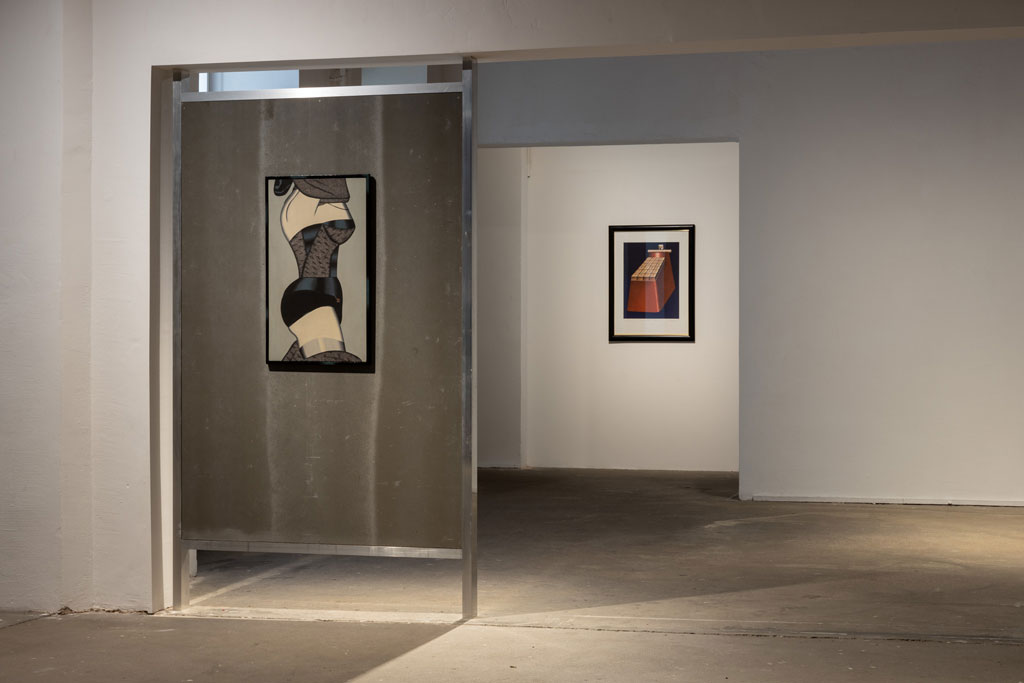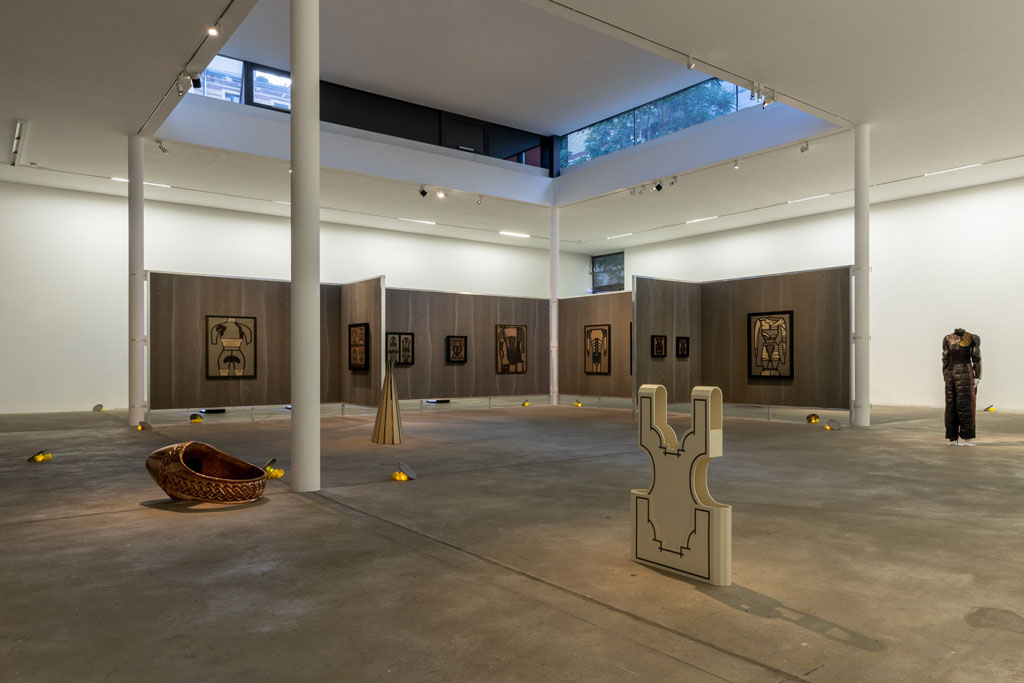ART CITIES:Berlin-The Making of Husbands
 Christina Ramberg was one of the most intriguing painters to emerge within a generation of Chicago Imagists. She left behind a significant body of comic, formally elegant, erotically sinister paintings. Her cropped torsos, sharply delineated and bound in bizarre variations, explore the body in traction with its environment, shaped by corsets and hairstyles, as well as behavioral conventions.
Christina Ramberg was one of the most intriguing painters to emerge within a generation of Chicago Imagists. She left behind a significant body of comic, formally elegant, erotically sinister paintings. Her cropped torsos, sharply delineated and bound in bizarre variations, explore the body in traction with its environment, shaped by corsets and hairstyles, as well as behavioral conventions.
By Dimitris Lempesis
Photo: KW Institute Archive
A selection of paintings and drawings by Christina Ramberg form the core of the exhibition at KW Institute for Contemporary Art. Shown alongside are works by further artists in order to expand the understanding of the type of framing devices that construct identity, physically, psychologically, and metaphorically. The exhibition title “The Making of Husbands: Christina Ramberg in Dialogue” stems from a BBC documentary that traced the making of John Cassavetes’ 1970 film “Husbands”, picking up on Cassavetes’ interest in the construction of semi-improvised behavioral and gender performances and complicating these through the meta-level of the documentary, which attempts to record the supposed “natural” behavior behind the scenes on set. By doing so, however, it reveals the artificiality of stereotypical roles such as “the husband,” the complexities of “acting natural,” and the constructed nature of gender itself. Artist and educator Christina Ramberg was a dynamic presence in the Chicago creative community from the 1960s up until her death in 1995. Through a plethora of small obsessive drawings, studies in sketchbooks, and a number of highly finished paintings in acrylic on Masonite, Ramberg observed the human body in various forms of modulation and metamorphosis. For her, this pictorial investigation doubled as an inquiry into larger questions concerning power dynamics, hierarchies, gender construction, desire, fetishism, and the increasing standardization thereof. From the early small-scale depictions of women in a state of undress to the later torso paintings, Ramberg’s surfaces and structural devices gradually merge with the body and become an androgynous prosthetic, a cyborg half-being. Ramberg’s rich and eccentric personal reference collection of 35 mm photographic research slides (parts of which are reproduced in the exhibition catalogue) reveals a wide range of visual influences on her painting including printed advertisements, fashion layouts, medical illustrations, S/M bondage, hosiery, comic books, folklore and self-taught art, costume history, and quilting. The slides delineate a specific way of looking at the world, at the then contemporary every day and at canonized visual culture alike. Equally, her collection of collages made from comic books expresses an interest in social conventions and how they are preprogrammed and perpetually re-inscribed through everyday visuals. Ramberg’s investigation of the body as a kinetic site in reciprocity with its environment is further explored in the accompanying group exhibition. The artistic positions articulate a relation of interdependence between the body and everyday objects, built constructions and infrastructure. They expand our understanding of how governing principles are at work and how they leave imprints on personal expression and social interaction. Marking the thresholds of the exhibition, Ghislaine Leung’s new commission “GATES” makes spatial circulation and questions of accessibility apparent and relatable, while her work “SHROOMS” highlights what is often overlooked or deemed neutral within an institutional body. Similarly accentuating KW’s infrastructure, Gaylen Gerber’s “Backdrop” fabricated from gray commercial photographic background paper and fitted to cover the gallery walls, draws attention to what is presented and how it is presented, both physically in the space and metaphorically by the institution. In close proximity Sara Deraedt’s photographs span a covert dynamic between desire, household objects and bodies. Kathleen White’s video documentation of her performance “The Spark Between L and D” alludes to the complex position of women within the narrative of the AIDS crisis and its biased commemoration. The body as a site that is overly programmed through historical, social, and technological mechanisms is further articulated in the multi-media-based practice of Terre Thaemlitz, Thaemlitz brings to the fore how the existence of humankind at all times has been grounded by all-defining organizational structures. The sexualized gaze of Konrad Klapheck onto the objects that we produce, such as technical equipment, machines, and everyday tools epitomizes Ramberg’s call for a reassessment of our built environment and its effect on the body. Similarly interested in a surrealistic, excessive take on everyday objects surrounding us, between 1978 and 1986 Ana Pellicer (born 1946, MX) created a series of oversized copper jewelry pieces to fit the Statue of Liberty in New York City for its centenary. A contemporary of Ramberg, Diane Simpson’s sculptures are abstractions of salient gendered garments that make the regulations and liberties that fashion and clothing leave to the body ever more apparent. Associated with a subsequent generation of Chicago artists, Richard Rezac’s objects are balanced structures of contrasting forms, substances, and functions that raise questions about structural and aesthetical integrity. Their inversion of an object’s qualities is akin to Ramberg’s formal transpositions. Alexandra Bircken explores in her sculptures the boundaries between inside and outside, fragility and protection, visibility and concealment. Bircken’s mechanical and industrial-looking shells become an interface where the body and the world come together, coalesce, and clash. In a similar negotiation between an inner and outer sphere, the painterly installation by Frieda Toranzo Jaeger reconsiders the gendering of the car as an archetypically masculine machine. She repositions the interiors of contemporary, soundless, electric vehicles made by imperialistic manufacturers as intimate, female spaces, in order to question the autonomy of the individual body within a world increasingly characterized by automated control. Embodying this notion of automatization against the autonomy of the artwork, Hans-Christian Lotz’s electric readymade sliding door suggests on the other hand a reading of aesthetic space as something intrinsically transmitted and mediated, it traces the viewer’s movement as they step in and out of its realm of attention. While articulating yet another structural tension—that of technical devices taken apart, as well as nylon tights reminiscent of skin, “A.C.Q. I” by Senga Nengudi outlines the brinks of a potentially performative space, referring to Nengudi’s ongoing involvement with acts of embodiment and ritualistic environments as sites for political negotiation.
Participating Artists: Alexandra Bircken, Rachal Bradley, Sara Deraedt, Gaylen Gerber, Frieda Toranzo Jaeger, Konrad Klapheck, Ghislaine Leung, Hans-Christian Lotz, Senga Nengudi, Ana Pellicer, Christina Ramberg, Richard Rezac, Diane Simpson, Terre Thaemlitz and Kathleen White
Info: Curator: Anna Gritz Assistant Curators: Kathrin Bentele, Léon Kruijswijk, KW Institute for Contemporary Art, Auguststraße 69, Berlin, Duration: 14/9/19-5/1/20, Days & Hours: Mon, Wed & Fri-Sun 11:00-19:00, Thu 11:00-21:00, www.kw-berlin.de



